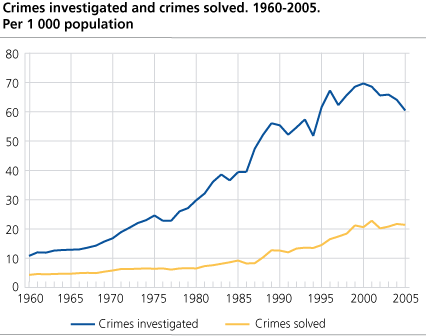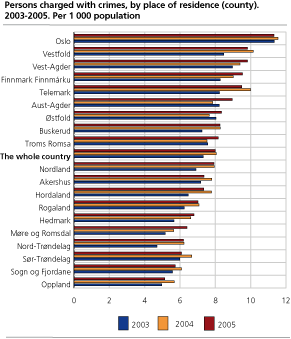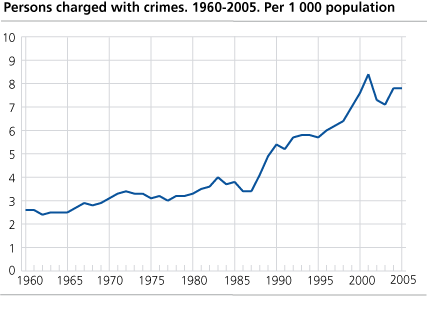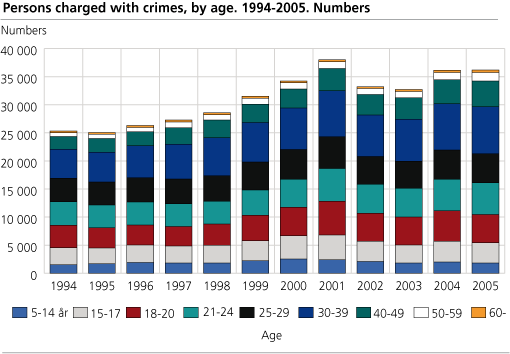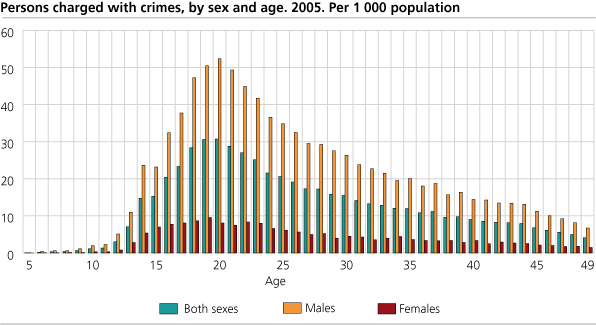Content
Published:
This is an archived release.
More adults charged with crimes
399 000 offences were investigated in 2005, a decrease of 3.4 per cent from the previous year. The number of misdemeanours remained stable from 2004, but investigated crimes decreased by 5 per cent. The number of persons charged continues to increase, and the proportion of persons charged aged 30 or over has never been higher.
Compared to the previous year, there was a 7.8 per cent decline in the number of completely investigated theft and other crimes for profit, and a 2.5 per cent decline in narcotic crimes. This increased in the other groups, with violent crimes having the largest increase in number of investigated offences (450 more) and sexual crimes having the largest percentage increase (5.6 per cent). Taking the population into account, the number of crimes has not been lower since 1994 (see figure).
In 2005, the number of completely investigated theft crimes was at its lowest level since 1987. Looking at the extent of offences over such long periods of time in crime statistics, population variations and the introduction and development of the criminal register system in the 1980s and 1990s must be taken into account (see also Offences reported to the police ). In light of this, we have to go at least 20 years back in time to find a year when the police and prosecuting authorities ended an equal or smaller amount of theft cases than in 2005.
| Offences investigated, by group of crime. 1996-2005. Numbers |
| 1996 | 1997 | 1998 | 1999 | 2000 | 2001 | 2002 | 2003 | 2004 | 2005 | ||||||||||||||||||||||||||||||
|---|---|---|---|---|---|---|---|---|---|---|---|---|---|---|---|---|---|---|---|---|---|---|---|---|---|---|---|---|---|---|---|---|---|---|---|---|---|---|---|
| Offences, total | 379 053 | 379 905 | 402 095 | 419 009 | 425 326 | 426 053 | 402 044 | 414 912 | 413 206 | 399 074 | |||||||||||||||||||||||||||||
| Crime, total | 275 421 | 272 653 | 292 258 | 307 063 | 314 027 | 310 447 | 298 500 | 301 699 | 295 192 | 280 524 | |||||||||||||||||||||||||||||
| Economic crime | 5 294 | 5 954 | 6 311 | 7 357 | 6 536 | 7 065 | 6 284 | 6 454 | 6 663 | 6 991 | |||||||||||||||||||||||||||||
| Other crimes for profit | 200 008 | 193 282 | 205 908 | 210 813 | 212 542 | 201 746 | 196 679 | 199 053 | 192 372 | 177 383 | |||||||||||||||||||||||||||||
| Crime of violence | 17 246 | 17 834 | 18 819 | 19 776 | 21 979 | 23 403 | 22 179 | 23 348 | 25 058 | 25 503 | |||||||||||||||||||||||||||||
| Sexual crime | 2 593 | 3 921 | 2 828 | 2 824 | 2 689 | 2 498 | 2 422 | 2 792 | 3 156 | 3 334 | |||||||||||||||||||||||||||||
| Crime of narcotics | 20 930 | 24 147 | 30 447 | 36 334 | 38 543 | 44 029 | 41 220 | 42 561 | 41 107 | 40 092 | |||||||||||||||||||||||||||||
| Crime inflicting damage to property | 23 115 | 20 585 | 20 659 | 22 190 | 24 312 | 22 954 | 19 956 | 18 957 | 18 387 | 18 430 | |||||||||||||||||||||||||||||
| Other crime1 | 6 235 | 6 930 | 7 286 | 7 769 | 7 426 | 8 752 | 9 760 | 8 534 | 8 449 | 8 791 | |||||||||||||||||||||||||||||
| 1 | Including environment crimes. |
Higher clear-up rate
In total, 49 per cent of all offences and 35 per cent of the 280 500 crimes carried out in 2005, were solved. The percentage of crimes solved was 1 per cent higher than in the previous year, and has not been higher since 1968. However, taking the population into account, the level of crimes solved by the police and prosecuting authorities has been relatively stable in the period 1999-2005 (see figure). Among the 195 7001 solved offences, 89 000 were committed for trial - of which one fourth of misdemeanours and one fifth of all crimes ended in court. In 2005, 28 per cent of crimes and 67 per cent of misdemeanours were either given on-the-spot fines or committed for trial.
Clear-up rate and share of persons charged varies in county and district
In 2005, 8 of 1 000 persons living in Norway were charged with one or more crimes. Oslo stands out from the rest of the country with the highest proportion of persons charged with crimes, (11.3 per 1 000 population). Compared to the previous year, Østfold and Møre og Romsdal had the largest increase in the number of persons charged with crimes, but Aust-Agder had the largest percentage increase (15 per cent). The proportion of the population charged with offences should, however, be seen in relation to the proportion of solved offences in the various regions. For instance, there is reason to believe that the proportion of charged Oslo and Sør-Trøndelag residents would have been considerably higher if these police districts had the same clear-up rate as Øst-Finnmark, Helgeland and Sogn og Fjordane - i.e. if half, and not one fourth, of all completely investigated crimes were solved.
More charged with misdemeanours, fewer with theft
In total, 84 700 individuals got one or more decisions with legal efficacy against themselves (excluding on-the-spot fines for traffic misdemeanours and misdemeanours against the Duty Act, see Sanctions ). An increase in the number of persons charged with misdemeanours in 2005, contributed to a 1 per cent increase in the total number of persons charged with offences compared with 2004. Compared to the previous year, an increasing number of persons were charged with principle offences against the Road Traffic or Duty Act as well as for disorderly conduct described in police regulations, the Act of Vagrancy and the alcohol legislation.
36 200 of the persons charged were given one or more decisions for one or more crimes. Even if the number of persons charged with crimes was unchanged, we find several considerable differences in type of principle offence among persons charged in 2004 and 2005: The number of persons charged with crimes for profit was 5 per cent lower than in the previous year. The decrease was basically among those below 25 years of age - and for persons charged with theft of motor vehicles (12 per cent lower), larceny and aggravated larceny (10 and 9 per cent lower) as principle offence. On the other hand, the number of persons charged with violent crimes (4 per cent), sexual crimes (12 per cent) and simple fraud (36 per cent) increased considerably.
More adults
Compared to the previous year, the extent of charged persons aged 30 years or older increased, whilst there was a decline in charged person below 30, particularly among persons below 21 years charged with crimes. All the oldest age groups saw an increase in the number of persons charged with both crimes and misdemeanours, also when taking population changes into account. Based on crime statistics in the period 1960-2005, never before have so many at the age 30 years and older been registered, in both numbers and share of population. In 2005, the number of persons charged with crime in this age group was 5 per cent higher than in 2004 and 20 per cent higher than in 2002. The age distribution among offenders has varied in different periods of time, but in the period 2000-2005 the share of persons charged with crimes aged 30 years and over increased from 36 to 41 per cent (see figures).
However, persons aged 18-20 are still over-represented in the statistics on persons charged with offences. In 2005, close to 5 per cent of all male residents in this age group were charged with one or more crimes, in addition to the 5 per cent charged with misdemeanours. In total, almost 2 per cent of women aged 18-20 were charged with offences in 2005. Men represented 85 per cent of all persons charged with crimes, and 82 per cent of all persons charged with misdemeanours. The distribution by sex has remained stable during the ten-year period 1996-2005, with the female share varying between 14-16 per cent for those charged with crimes and 16-18 per cent for those charged with misdemeanours.
Nine out of ten are Norwegian
87 per cent of all persons charged with crimes in 2005 were Norwegian citizens - and 7 per cent had citizenship in other European countries. The share of foreign citizens among persons charged with the different categories and groups of offences, have remained relatively stable in the period 2002-2005 (see textbox). The highest share of foreign citizens is found among those charged with theft, petty larceny and other offences for profit (19 per cent) as principle offence. Foreign citizens also represent a larger share among persons charged with traffic and narcotic offences (about 13 per cent) than for other groups of offences.
Many are charged several times
In 2005, 36 per cent of persons charged were registered as offenders for more than one offence. The survey on recidivism shows that many of the persons charged are caught for several offences over a longer period of time: Of all persons charged with crimes in 2000 (with official Norwegian reference number), 61 per cent were caught for at least one offence during the next five years. The largest recidivism, with 80 per cent, was among those with more serious types of theft and robbery as principle offence in 2000. Statistics for the period 2000-2005 also show other similarities with previous statistics on recidivism, e.g. a larger recidivism for men (50 per cent) than for women (32 per cent). As in previous years, the share of recidivism among men decreases considerably with higher age, whilst the share of recidivism among women increases up to the age group 30-39 years, where it is at its highest with 40 per cent.
News on statistics on offences investigated from 2002 included:- New police districts replace the previous geographical division. The possibilities of comparing these to statistics on police districts prior to 1 January 2002 are to a great extent restricted. - Several persons charged without registered and valid official Norwegian reference number are being identified if they have committed more than one offence. This gives a somewhat lower number of persons charged and a higher number of persons charged with more than one offence, for persons committing offences when on a temporarily residence in Norway in particular. - Statistics on the number of accessories shows to a greater extent the actual number of offenders with who the person charged has committed the offence in cooperation with. This involves a somewhat higher number of accessories than it would have been out of the previous method of surveying these. - Transfers to Conflict Council are only made available as settlement valid in law only against persons charged over the age of consent. This involves that the number of transfers to Conflict Council decreases, and that prosecutions dropped, the offender not liable, become correspondingly more. There have also been several other changes which have contributed to a quality improvement of the data basis and the statistics, something that to a greater extent will take effect in future volumes. The content in statistics on offences investigated 2005, will follow the same routines and definitions as for 2002-2004 statistics, and will be published during the next months. |
Police reform and change in routines for producing the statistics on offences investigatedAs of 1 January 2002, a new structure for the police districts was established; where for one thing the number of police districts was halved. Statistics Norway has as result of this, and the following technical re-adjustments in the central police criminal register system (BL/STRASAK/PAL, from October 2002 included), changed the routines for producing the statistics on offences investigated. Statistics Norway have in addition made a special treatment of data basis for the 2005 annual: Because of changed contents for date of decision in the data basis from the central police register, the statistics for 2005 are based on a main extract from May 2006 - which is almost a half year later than normal. This is the reason why Statistics Norway not until now has been able to publish the surveys on the completely investigated criminal cases in 2005. After a thorough examination of the different data basis and crime statistics, in addition to dialogue with Norwegian Police Data and Procurement Service (PDMT), Statistics Norway is of the opinion that the statistics on offences investigated 2005 has become fairly comparable to previous years. The police reform, together with the changes made in Statistics Norway's own categories (see textbox), is however of some importance to comparability of the statistics over longer time. Statistics are normally published in the third quarter the year after the statistical year, but the 2006 annual will because of the adjustments be about a half-year delayed. |
1Corrected 09.12.2008.
Contact
-
Reid Jone Stene
E-mail: reid.jone.stene@ssb.no
tel.: (+47) 99 02 22 01
-
Siri Fjærtoft Fossanger
E-mail: siri.fossanger@ssb.no
tel.: (+47) 99 72 49 27
-
Sigmund Book Mohn
E-mail: sigmund.mohn@ssb.no
tel.: (+47) 94 32 77 22

